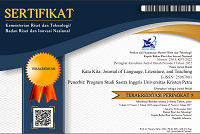Types of Code Mixing Used by Iman Usman and Faisal Basri in Gita Wirjawan’s Endgame
DOI:
https://doi.org/10.9744/katakita.11.3.434-441Abstract
This study was conducted to analyze the code-mixing types used by Iman Usman as a young adulthood resource person and Faisal Basri as a middle adulthood resource person in Gita Wirjawan’s Endgame, as well as the similarities and differences between the code mixing types used by both respondents. The writers used the theory of code-mixing types by Muysken (2000) and employed a qualitative approach. The findings of this study revealed that both used all the code-mixing types: insertion, alternation, and congruent lexicalization. Content words were also widely found and both Iman Usman and Faisal Basri repeatedly applied the code-mixing with possessed content word (nouns, verbs, adjectives, or adverbs). Moreover, age factor did really affect Iman Usman and Faisal Basri when using code-mixing in their conversation with Gita Wirjawan. Iman Usman used code mixing more often than Faisal Basri.
References
Erikson, E. H. (1977). Childhood and society. Paladin Grafton Books
Mulyajati, E. (2017). The Indonesian-English code-mixing in Just Alvin Show Metro tv Journal of English Language and Culture, 7(2), pp. 58-63.
Meyerhoff, M. (2006). Introducing sociolinguistics. Routledge.
Muysken, P. (2000). Billingual speech a typology of code-mixing. Cambridge University Press.
Samhan, A. H. (2017,). Social aspects in social media: Code switching and code mixing in Twitter IISTE, 7(18), pp. 110-115
Wardhaugh, R. (2006). An introduction to sociolinguistics. Blackwell Publishing Ltd.
Wirjawan, G. (n.d.). Home [YouTube Channel]. YouTube. https://www.youtube.com/c/GitaWirjawan45
Wirjawan, G. (2021, January 13). Iman Usman: good enough is not enough: Endgame #S2E07 [Video]. YouTube. https://www.youtube.com/watch?v=bD9CCXtQ72E
Wirjawan, G. (2022, March 30). Indonesian economist: Business as usual not an option anymore: Endgame #S3E22 [Video]. YouTube. https://www.youtube.com/watch?v=52JHSp4HGYg&t=345s
Downloads
Published
Issue
Section
License
Authors who publish with this journal agree to the following terms:- Authors retain copyright and grant the journal right of first publication with the work simultaneously licensed under a Creative Commons Attribution License that allows others to share the work with an acknowledgement of the work's authorship and initial publication in this journal.
- Authors are able to enter into separate, additional contractual arrangements for the non-exclusive distribution of the journal's published version of the work (e.g., post it to an institutional repository or publish it in a book), with an acknowledgement of its initial publication in this journal.
- Authors are permitted and encouraged to post their work online (e.g., in institutional repositories or on their website) prior to and during the submission process, as it can lead to productive exchanges, as well as earlier and greater citation of published work (See The Effect of Open Access).














